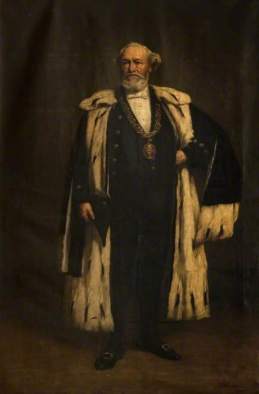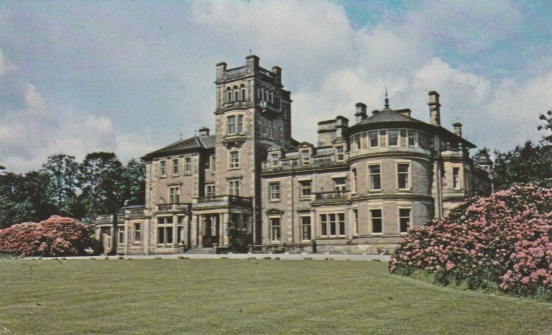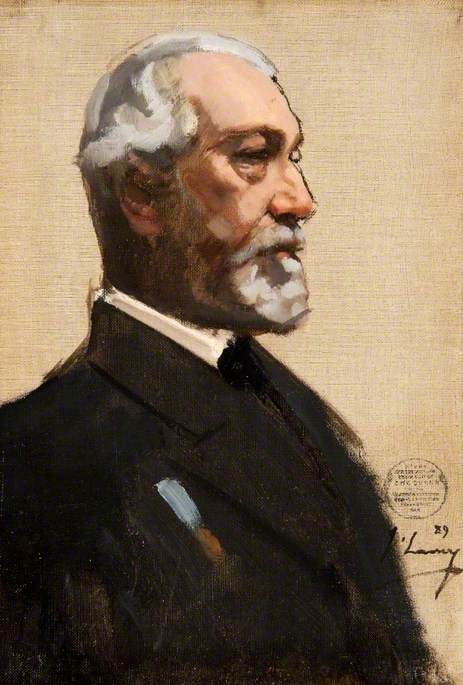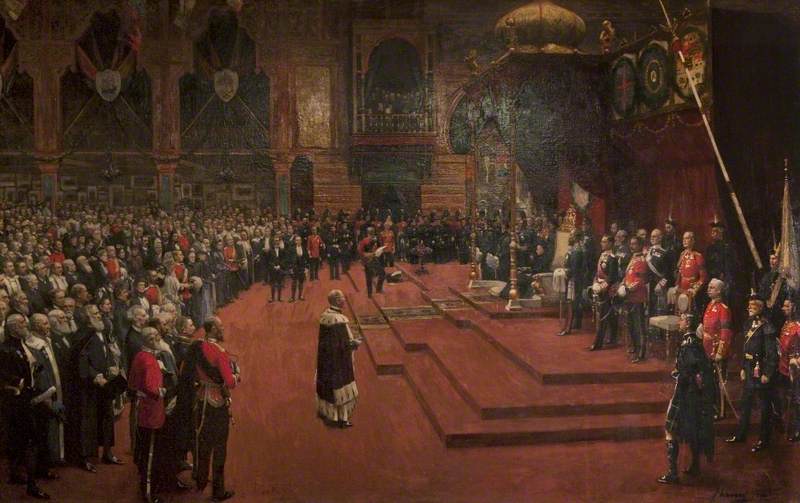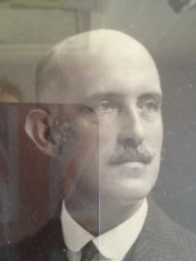
In 1945 Ernest Charteris Holford Wolff of Fair Oak Lodge, near Eastleigh, Hants, donated an oil painting, ‘Portrait of William Johnstone of Glenorchard’ by Sir Daniel Macnee, to Glasgow Museums.
The Wolff family originally came from Hamburg, Germany, Ernest’s paternal grandfather Arnold Julius Wolff being born there in 1798. He was the son of Carl Heinrich Wolff and his wife Maria Carolina Anna and was born at Ritzebuttel a town on the Elbe belonging to Hamburg where his father had been a protestant clergyman for over thirty years. He came to England in 1828[1] and subsequently married Lucy Taylor on 23 June 1831 in Manchester Cathedral (Church of St. Mary, St. Denys and St. George). She was a minor (age 17)[2] and required her father’s consent to the marriage. Arnold was a merchant, both he and the Taylor family living in the township of Chorlton Row which was part of the parish of Manchester.[3]
Arnold was employed by the cotton trading firm of James Holford & Co., who were the largest British exporters into Russia having branches in Russia, Britain, Germany (Hamburg) and the United States.[4] It may well be that Arnold had been employed by the company in Hamburg and had transferred to their offices in Manchester, however whilst likely, there is only circumstantial evidence to support that.
He became a naturalized British citizen in 1840, having become a partner in the Holford business some time before that.[5] However the business had been experiencing liquidity issues which resulted in some of its branches being taken over by its employees or partners. In Manchester the business, operating as Holford, Sauer & Co., was dissolved in January 1840 and taken over by Wollf and another employee to become Wolff, Hasche & Co.[6] It became a member of the Manchester Royal Exchange and continued to trade at least until 1853[7] and probably beyond that date.
Arnold and Lucy continued to live in Chorlton in the Greenheys area after their marriage and by 1841 had four children, two girls and two boys,[8] a third boy being born later that year.[9] Incidentally Thomas de Quincey lived in Greenheys as a youth, his father building the area in 1791.[10]
The eldest of the three boys was Arnold Holford Wolff. He was born on the 8th December, 1834 and baptised on the 18th May 1835.[11] By 1861 he along with his brother Ernest Julius were living in the family home at Greenhays and were in their father’s employ as clerks,[12] presumably in his export business. He was still living there with his mother and sister Lucy Catherine in 1871,[13] his father Arnold Julius having died in 1866. Probate was granted to his three sons, the estate being valued at “under £60,000”.[14]
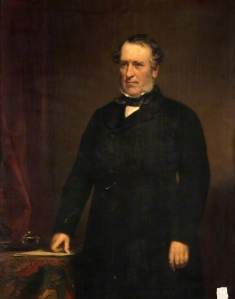
Arnold Holford Wolff, described as a ‘Russian merchant’, married Jane Johnstone Crawford on the 13th November 1872 in Edinburgh.[15] It was through his wife they ultimately came to possess the painting of William Johnston of Glenorchard, he being the brother of Jane’s mother Mary Johnstone.
The Johnstone family originated in the parish of Baldernock, then in Stirlingshire, where Thomas Johnstone and Mary Baird were married in 1803.[16] They had six children all born in Baldernock including the aforementioned William (b.1805)[17] and Mary (b.1812).[18]
William married Agnes Ewing in 1846 at Dunoon Parish Church.[19] He was a banker and had been an agent of the Commercial Bank of Scotland since 1845.[20] In 1848 he and his wife were living in the Barony Parish of Glasgow at 5 Newton Place,[21] staying there until 1858-59.[22] They became tenants of Glenorchard House around 1855 but did not permanently reside there until 1859.[23] He subsequently became the owner of the estate sometime between 1858 and 1861,[24] living there, still with the Commercial Bank, until he died.[25]
He died in 1864, not at Glenorchard, but at 200 Bath Street, Glasgow, the home of James Campbell jnr. of J & W Campbell & Co., Warehousemen.[26] The cause of death was recorded as apoplexy.[27]
He left estate valued at just over £27,100 and had set up a Trust Disposition and Settlement early in 1863 which essentially took care of his widow, his siblings where they survived, and their children, there being no children of his own marriage.[28] In particular his niece Jane (Johnstone) Crawford, the daughter of his sister Mary who had died in 1855[29], and who lived with William and his wife Agnes following her father John Crawford’s death in 1861[30], received initially £150 per quarter. On Agnes’s death he stipulated that Jane was to receive £3,000.[31]
Jane was born on the 5th February 1849[32], the last of four children. Her parents had married in 1842,[33] John being a grocer and spirit merchant in Shettleston.[34] She continued to live with her aunt Agnes following her uncle’s death, remaining with her at Glenorchard.[35] Sometime after 1871 Agnes and Jane moved to Edinburgh living at 32 Moray Place which is where Jane’s marriage to Arnold Holford Wolff took place.[36]
Her aunt died on the 15th March 1873 leaving Jane £5,000 and some personal items.[37] Although the Macnee painting is not specifically mentioned it is clear it came into Jane’s possession either when she married or as a bequest.
Jane and Arnold had two boys, Arnold Johnstone Wolff (b.1873)[38] and Ernest Charteris Holford Wolff who was born on the 3rd July 1875.[39] In late 1880 Jane was widowed when Arnold senior died at the age of 46 leaving her to bring up her two young sons.
By 1891, at the age of 17, Arnold jnr. was attending the Royal Military Academy,[40] subsequently joining the Royal Engineers as a Lieutenant. He served in the Boer Wars between 1899 – 1902 gaining the Queen’s South Africa medal with clasps for the Orange Free State, Cape Colony and the Transvaal. He was also awarded the King’s South Africa medal with clasps for 1901 and 1902.[41]
He saw further service during WW1 gaining promotion eventually to Lieutenant Colonel.[42] He was awarded the Distinguished Service Order in February 1916 at which time he was at his final rank on a temporary basis.[43] He retired from the army sometime after 1922 and by 1939 he and his wife Nora Gladys Platt, whom he married in 1905,[44] were living in Southampton[45]. He died there in 1941 leaving an estate valued at just under £27,500.[46]
In 1891 Ernest was living with his mother in Edinburgh, still at school,[47] subsequently going to Oxford where he graduated BA in 1897. He joined the colonial civil service that year with the Pahang Government,[48] travelling in November to take up his post on the SS Himalaya to Colombo, Ceylon, then on the SS Thames for Malaysia.[49]
Pahang was part of the Federated Malay States (FMS) which also included Selangor, Perak and Negri Sembilan. Between 1897 and 1908 he held a variety of positions within FMS becoming secretary to the British Resident of Negri Sembilan in 1901, taking on additional roles in 1904 (Sanitary Board chairman, Seremban) and 1905 (District Treasurer of Telek Anson). By 1908 he was the secretary to the Resident General of the colony. In 1923 he was appointed by the King as an Official Member of the Legislative Council of the Straits Settlements.[50]
He was also a very keen sportsman being on the committees of the Selangor Polo and Golf clubs in 1909,[51] and was captain of the golf club from 1907 to 1909.[52] He won the club championship in 1907/08 and subsequently the Coronation Cup.[53]
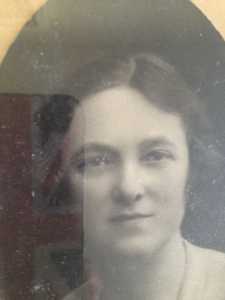
He married Mary Lilias Alison on the 6th December 1911 at Grange Parish Church of Scotland, Edinburgh. She was the daughter the Rev, John Alison of Edinburgh and Margaret McGeorge.[54] They had two daughters, Stella (b.?) and Alison Jean (b.1914).[55]
Ernest’s civil service career continued to progress and in 1924 he became the British Resident of Negri Sembilan, retaining that position until 1928 when he retired to Fair Oak Lodge, Hants,[56] where he lived for most of the rest of his life. In January of that year he was appointed Companion of the Order of St. Michael and St. George (C.M.G.).[57]
He and his wife travelled home on the SS Empress of Canada, embarking from Hong Kong on the 6th April 1928 and arriving in Victoria, British Columbia on the 6th May for a month long tour of Canada. Following the tour they travelled home to Southampton where his brother Arnold lived at Bitterne Park.[58]
It’s not clear when the Macnee painting came into his possession. Did his mother Jane leave it directly to him or did it first go to his brother Arnold who bequeathed it to him on his death in 1941? However, on the 9th July 1945 Ernest presented the painting to Glasgow,[59] just a few months before he died.
He died on the 23rd April 1946 at Cheniston Compton near Winchester leaving estate to the value of £12,420, probate being granted to his wife Mary and George Eaton Stannard Cubitt.[60]
The Wolff family motto was “Res non verba” [61] which translates as “deeds not words”, which, it seems to me, all members of the family lived up to.
Note: Johnstone is spelled with or without an e in various records.
[1] National Archives. March 1840. Naturalisation of WOLFF, Arnold Julius. HO/1/16/48 http://discovery.nationalarchives.gov.uk/details/r/C9171229
[2] Baptisms (NCR) England & Wales. Manchester, Lancashire. 8 April 1814. TAYLOR, Lucy. Class Number: RG 4; Piece Number: 2009. Collection: Non-Conformist and Non-Parochial Registers, 1567-1970. http://www.ancestry.co.uk
[3] Marriages (PR) England. Manchester, Lancashire. 23 June 1831. WOLFF, Arnold Julius and TAYLOR, Lucy. Collection: Manchester, England, Marriages and Banns, 1754-1930 (Cathedral). Archive Roll 699. http://www.ancestry.com
[4] Edmondson, Linda and Waldron, Peter, eds. (1992) Economy and Society in Russia and the Soviet Union, 1860 – 1930. p. 111. https://www.google.com/search?tbm=bks&q=Economy+and+Society+in+Russia+and+the+Soviet+Union
[5] National Archives. March 1840. Naturalisation of WOLFF, Arnold Julius. HO/1/16/48 http://discovery.nationalarchives.gov.uk/details/r/C9171229
[6] London Gazette (1840) Vol.1 24 March 1840. Holford, Sauer & Co. p. 773. https://books.google.co.uk/books?id=CxlKAQAAMAAJ
[7] Directories. England. (1853) Directory of Manchester and Salford, 1853. p.516. Collection: UK, City and County Directories, 1766 – 1946. http://www.ancestry.com
[8] Census. 1841. England. Chorlton, Lancashire. Class: H0107; Piece: 580; Book: 19; ED: 34: Folio: 9; Page: 9; Line: 9; GSU roll: 4388732. http://www.ancestry.com
[9] Baptisms (NCR) England. Manchester, Lancashire. 13 October 1841. WOLFF, Ernest Julius. FHL Film Number223716. Collection: England, Births and Christenings, 1538-1975. http://www.ancestry.com
[10] British History Online. Chorlton-Upon-Medlock. http://www.british-history.ac.uk/vch/lancs/vol4/pp251-254
[11] Baptisms (NCR) England. Manchester, Lancashire. 8 December 1834. WOLFF, Arnold Holford. Class Number: RG 4; Piece Number: 2009. Collection: Non-Conformist and Non-Parochial Registers, 1567-1970. http://www.ancestry.co.uk
[12] Census. 1861. England. Chorlton, Lancashire. Class: RG 9; Piece: 2885; ED: 42; Folio: 21; Page: 35; GSU roll: 543044. http://www.ancestry.com
[13] Census. 1871. England. Chorlton, Lancashire. Class: RG 10; Piece: 4007; ED: 71; Folio: 11; Page: 13; GSU roll: 846104. http://www.ancestry.com
[14] Testamentary records. England. 10 April 1866. WOLFF, Arnold Julius. Principal Probate Registry. Calendar of the Grants of Probate. p. 438. Collection: England & Wales National Probate Calendar 1858-1966. http://www.ancestry.com
[15] Marriages (CR) Scotland. St George, Edinburgh. 13 November 1872. WOLFF, Arnold Holford and CRAWFORD, Jane Johnstone. 685/1 322. http://www.scotlandspeople.gov.uk
[16] Marriages. (OPR) Scotland. Baldernock, Stirlingshire. 3 June 1803. JOHNSTON, Thomas and BAIRD, Mary. 471/ 10 417.
http://www.scotlandspeople.gov.uk
[17] Baptisms. (OPR) Scotland. Baldernock, Stirlingshire. 5 January 1806 JOHNSTONE, William 471/ 10 292. http://www.scotlandspeople.gov.uk
[18] Baptisms (OPR) Scotland. Baldernock, Stirlingshire. 8 April 1812. JOHNSTONE, Mary. 471/ 10 311. http://www.scotlandspeople.gov.uk
[19] Marriages. (OPR) Scotland. Dunoon and Kilmun. 6 October 1846. JOHNSTON, William and EWING, Agnes. 510/ 30 386. http://www.scotlandspeople.gov.uk
[20] Directories. Scotland. (1845-46) Post Office Annual Glasgow Directory. Glasgow: Edward Khull. Appendix p.167. http://digital.nls.uk/83849228
[21] Directories. Scotland (1848-49) Post Office Annual Glasgow Directory. Glasgow: William Collins & Co. p. 151. http://digital.nls.uk/90167004
[22] Directories. Scotland (1858-59) Post Office Glasgow Directory. Glasgow: William McKenzie. p. 142. http://digital.nls.uk/90167004
[23] Directories. Scotland (1859-60) Post Office Glasgow Directory. Glasgow: William McKenzie. p. 148. http://digital.nls.uk/83897776
[24] Ordnance Survey Names Book. Stirlingshire OS Names Books Vol. 3 1858-1861. OS1/32/28. http://www.scotlandsplaces.gov.uk/records
[25] Directories. Scotland (1864-65) Post Office Glasgow Directory. Glasgow: William McKenzie. p. 169. http://digital.nls.uk/83927716
[26] Directories. Scotland (1864-65) Post Office Glasgow Directory. Glasgow: William McKenzie. p. 88 http://digital.nls.uk/83926744
[27] Deaths (CR) Scotland. Blythswood, Glasgow. 6 December 1864. JOHNSTON, William. 644/6 569. http://www.scotlandspeople.gov.uk
[28] Testamentary records. Scotland. 3 February 1865. JOHNSTON, William. Trust Disposition and settlement. Stirling Sheriff Court. SC67/36/49. http://www.scotlandspeople.gov.uk
[29] Deaths. (CR) Scotland. Shettleston, Lanark. 23 December 1855. CRAWFORD, Mary. 622/3 120 http://www.scotlandspeople.gov.uk
[30] Deaths. (CR) Scotland. Shettleston, Lanark. 5 December 1861. CRAWFORD, John. 622/3 131. http://www.scotlandspeople.gov.uk
[31] Testamentary records. Scotland. 3 February 1865. JOHNSTON, William. Trust Disposition and settlement. Stirling Sheriff Court. SC67/36/49. http://www.scotlandspeople.gov.uk
[32] Births. (OPR) Scotland. Barony. 6 January 1849. CRAWFORD, Jane Johnston. 622/ 130 378. http://www.scotlandspeople.gov.uk
[33] Marriages. (OPR) Scotland. New Kilpatrick. 3 August 1842. CRAWFORD, John and JOHNSTON, Mary. 500/ 30 277. http://www.scotlandspeople.gov.uk
[34] Directories. Scotland (1855-56) Post Office Glasgow Directory. Glasgow: William McKenzie. p. 690. http://digital.nls.uk/84138937
[35] Census. 1871 Scotland. Baldernock, Stirlingshire. 471/ 1/ 10. http://www.scotlandspeople.gov.uk
[36] Marriages (CR) Scotland. St George, Edinburgh. 13 November 1872. WOLFF, Arnold Holford and CRAWFORD, Jane Johnstone. 685/1 322. http://www.scotlandspeople.gov.uk
[37] Testamentary records. Scotland. 1 September 1873. JOHNSTON, Agnes. Trust Disposition and settlement. Edinburgh Sheriff Court Wills. SC70/4/146. http://www.scotlandspeople.gov.uk
[38] Baptisms (CR) England. Manchester, Lancashire. 10 November 1873. WOLFF, Arnold Johnston. Collection: England, Non-Conformist Births and Baptisms, 1758-1912. http://www.ancestry.com
[39] Baptisms (CR) England. Manchester, Lancashire. 6 September 1875. WOLFF, Ernest Charteris Holford. Collection: England, Non-Conformist Births and Baptisms, 1758-1912. http://www.ancestry.com
[40] Census. 1891. England. Woolwich, London. Class: RG12; Piece: 534; ED: 34: Folio: 44; Page: 9; Line: 9; GSU roll: 6095644. http://www.ancestry.com
[41] War Office (Great Britain). Record of Service. WOLFF, Arnold Johnston. WO100/157 page 56, WO100/314 page 58 FindMyPast Transcription. Collection: Anglo-Boer War Records 1898-1902. http://www.findmypast.co.uk
[42] War Office (Great Britain). Record of Service. WOLFF, Arnold Johnston. Lieutenant Colonel, Royal Engineers 1922. Collection: British Army Lists, 1882-1962. http://www.ancestry.com
[43] London Gazette (1916) Supplement. 2 February 1916. Military Award, Companion of D.S.O. WOLFF, Arnold Johnston, p.1336, 1337.
https://www.thegazette.co.uk/London/issue/29460/supplement/1337/data.pdf
[44] Marriages Index (CR) England & Wales. RD: Hampstead, London. Last Qtr. 1905. WOLFF, Arnold Johnston and PLATT, Nora Gladys. Vol.1a. p.1415. Collection: England & Wales, Civil Registration Marriage Index, 1837-1915. http://www.ancestry.com
[45] 1939 Register. England. Southampton, Hampshire. ‘Sandyhayes’, Thorold Road. WOLFF, Arnold Johnston. http://www.ancestry.com
[46] Testamentary records. England. 2 September 1941. WOLFF, Arnold Johnston. Principal Probate Registry. Calendar of the Grants of Probate. p. 432. Collection: England & Wales National Probate Calendar 1858-1966. http://www.ancestry.com
[47] Census. 1891 Scotland. Newington, Midlothian. 685/5 130/7. http://www.scotlandspeople.gov.uk
[48] Wright, Arnold. (1908). Twentieth Century Impressions of British Malaya. London et al: Lloyd’s Greater Britain Publishing Company Ltd. p.128 http://seasiavisions.library.cornell.edu/catalog/seapage:233_134
[49] Passengers Lists (1897) The Homeward Mail. Vol. XLIII, issue 2051. 13 November. WOLFF, E.C.H. p.1543. http://search.findmypast.co.uk/bna/viewarticle?id=bl%2f0001712%2f18971113%2f091
[50] Edinburgh Gazette (1923). 7 August 1923. WOLFF, Ernest Charteris Holford. Appoint to Legislative Council of the Strats Settlements, p. 1105. https://www.thegazette.co.uk/Edinburgh/issue/13942/page/1105/data.pdf
[l51 Directory and Chronicle for Malay States et al (1909). p.1298. https://play.google.com/store/books/details?id=f5VEAQAAMAAJ&rdid=book-f5VEAQAAMAAJ&rdot=1
[52] Royal Selangor Golf Club (RSGC). Club Captains. https://www.rsgc.com.my/past-captains
[53] Wright, Arnold. (1908). Twentieth Century Impressions of British Malaya. London et al: Lloyd’s Greater Britain Publishing Company Ltd. p.128 http://seasiavisions.library.cornell.edu/catalog/seapage:233_134
[54] Marriages (CR) Scotland. Newington, Midlothian. 6 December 1911. WOLFF, Ernest, Charteris, Holford and ALISON, Mary Lilias. 685/5 247. http://www.scotlandspeople.gov.uk
[55] Births Index (CR) England & Wales. RD: Cheltenham, Gloucestershire. 17 July 1914. WOLFF, Alison Jeans. C44D, 4791C, Entry No. 147. Collection: England & Wales, Civil Registration Death Index, 1916-2007. http://www.ancestry.com
[56] Fox-Davies, Arthur Charles (1929) Armorial Families: A Directory of Gentlemen of Coat-Armour. 7th ed. Vol.2. London: Hurst & Blackett Ltd. p. 2125. https://archive.org/stream/armorialfamilies02foxd#page/n11/mode/2up/search/wolff
[57] London Gazette (1928) Supplement. 2 January 1928. Companion of C.M.G. WOLFF, Ernest Charteris Holford, p. 5. https://www.thegazette.co.uk/London/issue/33343/supplement/5/data.pdf
[58] Passenger List for S.S. Empress of Canada departing Hong Kong WOLFF, Ernest Charteris Holford. 6 April 1928. Collection: Canadian Passenger Lists, 1865-1935 and Washington, Passenger and Crew Lists, 1882-1965 http://www.ancestry.com
[59] Glasgow Museums Resource Centre.
[60] Testamentary records. England. 23 April 1946. WOLFF, Ernest Charteris Holford. Principal Probate Registry. Calendar of the Grants of Probate. p. 585. Collection: England & Wales National Probate Calendar 1858-1966. http://www.ancestry.com
[61] Fox-Davies. op. cit.

